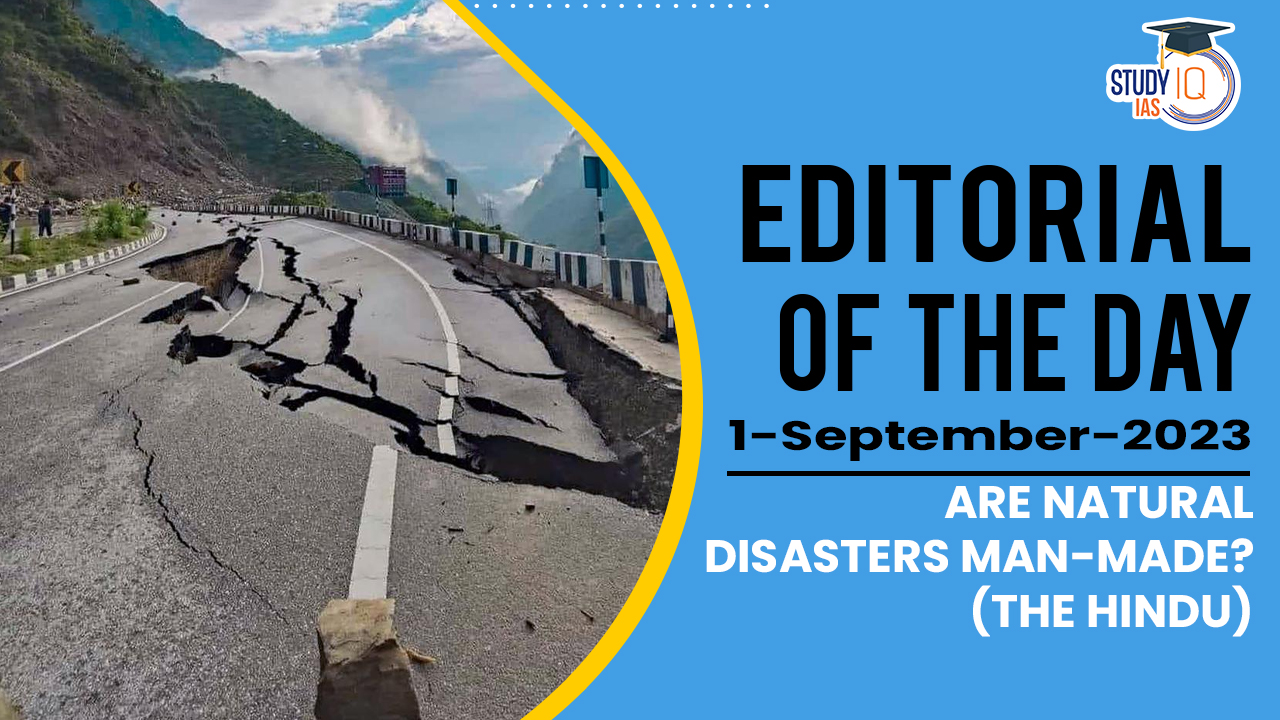Context: The article is discussing the occurrence of natural disasters, particularly extreme rainfall and its consequences, in several parts of North India, such as Himachal Pradesh and Uttarakhand. It highlights that these disasters, which have caused damage to highways, buildings, and loss of lives, are not solely the result of natural factors like heavy rains but also have a significant human-made component. The article primarily discusses climate change and the warming Arctic, poor Planning and Construction and the role of human actions. Overall, the article is highlighting the complex interplay between natural factors, climate change, and human activities in the context of natural disasters, emphasizing the need for better planning and preparedness to mitigate their effects.
Decoding the Editorial
The article discusses the following dimensions:
- Climate change and the warming Arctic: The article mentions that a warming Arctic is considered one of the factors contributing to unusually heavy rains. This suggests that changes in the climate, which are often linked to human activities such as the emission of greenhouse gases, can influence the intensity and frequency of extreme weather events like heavy rainfall.
- Poor Planning and Construction: It also points out that years of haphazard planning and construction have exacerbated the impact of these natural disasters. This implies that inadequate urban planning, deforestation, and construction in vulnerable areas can worsen the consequences of heavy rains and other natural calamities.
- The Role of Human Actions: The overarching question raised in the article is whether natural disasters are solely acts of nature or if human actions and decisions contribute significantly to their severity and impact. It suggests that a combination of factors, including climate change and poor planning, can turn natural events into major disasters.
To what extent are natural disasters man-made?
According to the experts,
- The scale of natural disasters seen worldwide is definitely influenced by human actions.
- It is argued that some sections of the population are more vulnerable to these disasters than others and there is a need to develop systems and solutions aimed at addressing the vulnerabilities of these groups.
- Building stronger systems from the bottom up and collective efforts to mitigate the impact of natural disasters is what is needed.
Changing Landscape for Disasters:
The excerpt is discussing how the landscape of disasters in India has changed over the years, particularly in the context of urbanization and its impact on natural ecosystems.
- There are concerns about urban planning and the movement of people to urban centers, which has led to some landscapes exceeding their carrying capacity and exacerbating the extent of damage caused by disasters.
- Certain regions, like Mumbai, have taken steps to improve disaster preparedness, including the establishment of a Disaster Management Agency, engagement with research institutions for better flood prediction models, and the construction of larger water-holding tanks by the Municipal Corporation’s storm-water drainage department.
- As a result, Mumbai has been able to perform better in managing floods compared to other cities like Delhi.
- However, there are still concerns about the long-term sustainability of certain development practices and the need to prioritize natural ecosystems and systems in urban planning.
The experts express their opinions and insights on various aspects related to urbanization, sustainability, knowledge, and decision-making concerning climate hazards and natural disasters:
Urbanization and Sustainability:
- The experts emphasise that while development often translates to infrastructure growth, there has been insufficient attention paid to whether development pathways are sustainable.
- They argue that true sustainability considers not only economics but also societal and environmental aspects, which have been neglected in favor of economic interests.
- Adopting Sustainable Development Goals, careful urban planning, and considering environmental implications are essential.
Challenges in Decision-Making:
- The article acknowledges that people’s need for houses, jobs, and services drives development and growth.
- However, certain business-as-usual practices persist in city planning, leading to challenges.
- There is a need for long-term solutions, including risk and vulnerability assessments, and understanding how socioeconomic drivers worsen problems in certain communities.
Knowledge and Awareness:
- The experts explain that knowledge is not static but continuously evolving.
- They acknowledge that there is existing knowledge based on past events, but the challenge often arises from a lack of awareness or underestimation of risks.
- It is pointed out that risks are not always clearly estimated or defined when implementing new infrastructure projects. Additionally, they highlight issues related to inadequate data and observational networks in certain regions, which can hinder risk assessment.
Role of Government Institutions:
- There are excellent government institutions monitoring and understanding climate crisis impacts, such as rainfall patterns and trends.
- However, the disconnect lies in decision-making processes.
- Therefore the decisions need to be made more transformatively, considering carrying capacity, restricting urbanization in vulnerable regions, and involving experts from both private and public agencies to develop modern solutions.
Political Will:
The article concludes by raising the question of whether there is the political will to take action in a manner that aligns with expert recommendations.


 Daily Quiz 05 July 2025
Daily Quiz 05 July 2025
 SSC MTS Apply Online for 1075 Posts – ...
SSC MTS Apply Online for 1075 Posts – ...
 Dynamic Pricing: What It Is and Why It's...
Dynamic Pricing: What It Is and Why It's...





















